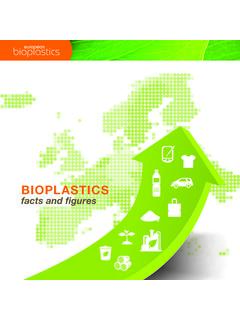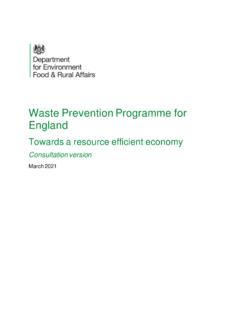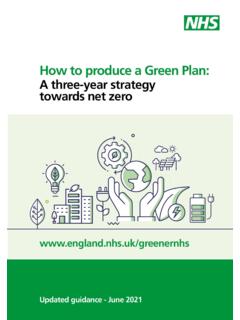Transcription of Towards a more resource-efficient and circular economy The ...
1 Towards a more resource-efficientand circular economyThe role of the G20 | 1 Towards A MORE resource-efficient AND circular economy OECD 2021 A background report prepared for the 2021 G20 Presidency of Italy Towards a more resource-efficient and circular economy The role of the G20 PUBE 2 | Towards A MORE resource-efficient AND circular economy OECD 2021 Table of contents Executive Summary 4 1. Introduction 9 2. Past trends in material consumption and waste generation 10 3. Projections of future materials use 18 4. The environmental impacts of materials use 21 5. A transition to a circular economy can lower resource demands and environmental impacts and contribute to the economic and social recovery 24 6.
2 Recent developments on resource efficiency and circular economy policies 27 7. The role of cities Towards the circular economy transition 32 8. Towards a G20 policy vision on resource efficiency 38 References 47 | 3 Towards A MORE resource-efficient AND circular economy OECD 2021 Tables Table 1. Selected environmental impacts of materials use 21 Table 2. Selected examples of national, regional and local strategies for resource efficiency, waste management and the circular economy of G20 countries 27 Figures Figure 1. Domestic Material Consumption in G20, OECD and BRIICS 10 Figure 2. Domestic material consumption per capita [tonnes] 11 Figure 3. Resource productivity levels differ substantially among G20 countries, but some improvements could be achieved 12 Figure 4.
3 Despite improvements in resource productivity, domestic material consumption increased in G20 countries 13 Figure 5. Material footprint per capita remains high also for countries with low Domestic Material Consumption per capita 14 Figure 6. As income levels rise, waste generation increases [left], but waste treatment processes improve [right] 15 Figure 7. Trends waste and scrap trade in G20 countries 16 Figure 8. Partial decoupling between economic growth and materials use is projected to continue globally 18 Figure 9. Global materials use is projected to further increase in the coming decades 19 Figure 10. Materials use projections by category and region 20 Figure 11. Global greenhouse gas (GHG) emissions are projected to further increase, with more than two-thirds linked to the materials cycle 22 Figure 12.
4 Projections of global environmental impacts from different materials 23 Figure 13. circular business models help close material loops and reduce material throughput 25 Figure 14. Cumulative EPR adoption at the global level 29 Figure 15. Share of surveyed cities and regions with circular economy initiatives in place 34 Figure 16. Main obstacles to the circular economy in surveyed cities and regions 35 Figure 17. The share of ODA commitments by G20 donor countries for the purpose of resource efficiency and waste projects is low 41 Figure 18. waste management hierarchy and complementary policy actions 42 Figure 19. The governance of the circular economy in cities and regions: A Checklist for Action 44 Boxes Box 1. Textiles and the circular economy 15 Box 2. The construction sector and the circular economy 19 Box 3.
5 Resource efficiency at the G20 and G7 28 Box 4. The rise of plastics on the political agenda 28 Box 5. The 3Ps framework: people, policies, place 32 Box 6. Mainstream resource efficiency in COVID-19 recovery packages 39 Box 7. Significant effects could be achieved if resource efficiency was mainstreamed into ODA more systematically 41 4 | Towards A MORE resource-efficient AND circular economy OECD 2021 G20 countries account for approximately 75% of global materials use and 80% of global greenhouse gas emissions. G20 governments thus play a key role in working Towards increased resource efficiency and material circularity. While average resource productivity of the G20 grew by about 40% between 2000 and 2017 and more improvements in resource productivity are projected to take place in the future, these will not be sufficient to offset the global increase in materials use (OECD, 2019[1]).
6 Moreover, when accounting for materials embedded in trade, resource efficiency improvements of most G20 countries are more modest. Unless further efforts are taken to increase resource efficiency, close material loops, and improve sustainable materials management , the growing volumes of materials use will result in significant environmental pressures, including land degradation, greenhouse gas emissions and the dispersion of toxic substances in the environment. With benefits in environmental, economic and social domains, there is a clear rationale for G20 countries to further advance the transition to a more resource efficient and circular economy . Several G20 countries have started to develop national strategies for sustainable materials management , resource productivity or the circular economy .
7 At the G20, resource efficiency has been on the agenda since 2017 and annual G20 Resource Efficiency Dialogues have been held since, providing a platform for exchanging views, policy experiences and good practices. Going forward, the G20 could further advance joint work on resource efficiency and the circular economy . This Policy Guidance, prepared by the OECD at the request of the Italian G20 Presidency is intended for G20 Leaders, as well as Economic, Finance and Environment Ministries. Based on insights from across the G20 membership, this report presents possible elements of a common G20 policy vision on resource efficiency and the circular economy for different levels of government. It is expected that the vision would help to coordinate and align individual country efforts and foster international co-operation among G20 members.
8 They key elements of a possible G20 policy vision are summarised hereafter. National and sub-national action to advance Towards a more resource efficient and circular economy Resource efficiency and circular economy principles need to be mainstreamed in domestic policies, taking into account specific country contexts. National and sub-national action also needs to be aligned to fully leverage the role of cities in improving materials management . Mainstream resource efficiency and circular economy principles into domestic policies Promote resource efficiency through a policy mix that covers the full lifecycle of products Environmental risks are complex and need to be managed in an integrated way. This requires the application of a policy mix that considers the entire lifecycle of products, to avoid simply displacing environmental burdens to different lifecycle stages or from one environmental medium to another.
9 A policy mix of economic instruments, regulations, information-based and voluntary approaches, environmental labelling and public financial support should internalise environmental costs and provide incentives for efficient resource use. Examples of policies that can generate environmentally effective and economically efficient outcomes include Extended Producer Responsibility (EPR), Green Public Procurement (GPP) Executive Summary | 5 Towards A MORE resource-efficient AND circular economy OECD 2021 with integrated lifecycle analysis, or partnerships with businesses and stakeholders across the value chain to support industrial symbiosis and innovation for improved eco-design. Align sectoral policies with resource efficiency objectives The transition to a circular economy requires a comprehensive set of policy measures at the macroeconomic and sectoral level.
10 Resource efficiency and circular economy should be approached as an economy -wide issue, recognising the economic benefits with regards to competitiveness, new business opportunities and innovation, as well as greater resilience against scarcity of resources and volatile prices,. Furthermore, opportunities should be sought to exploit synergies with other policy areas, including climate change. Governments can support the resource-efficient structural economic change by mainstreaming the pursuit of resource efficiency into cross-cutting policies such as in innovation, investment and education and vocational training and by aligning policies to reduce pressures from major resource-consuming sectors. Align COVID-19 recovery measures with resource efficiency objectives In response to the COVID-19 pandemic, many countries committed to a green recovery through stimulus packages of unprecedented scale.












